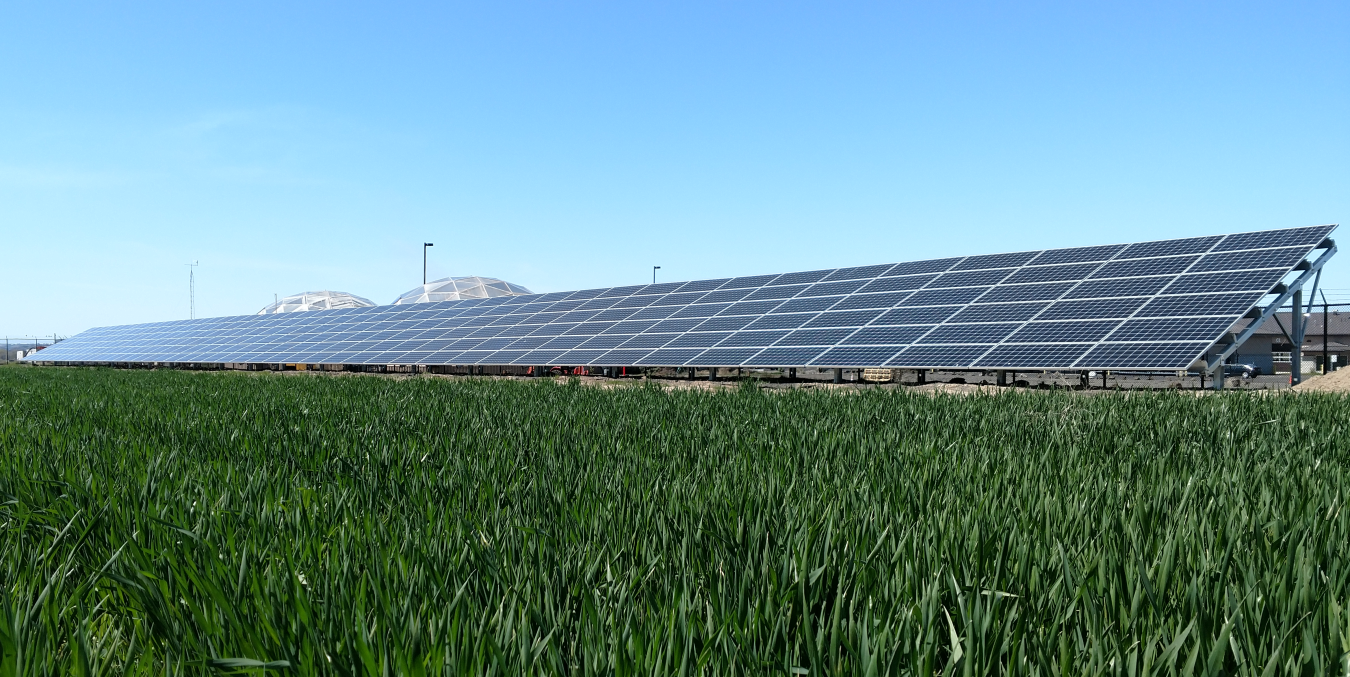The Tribe turned a strip of its land in Oregon into nearly $12,000 in annual energy cost savings.
Office of Indian Energy Policy and Programs
August 27, 2018
The Ántukš-Tińqapapt or “sun trap” solar array recently installed by the Confederated Tribes of the Umatilla Indian Reservation in Oregon.
The Confederated Tribes of the Umatilla Indian Reservation (CTUIR), a union of three tribes: Cayuse, Umatilla, and Walla Walla, turned a strip of its land near the Blue Mountains in Oregon into nearly $12,000 in annual energy cost savings and an almost 23-ton reduction in carbon dioxide emissions each year with its newly installed solar photovoltaic (PV) array and light-emitting diode (LED) retrofit—thanks in part to funding from the U.S. Department of Energy (DOE) Office of Indian Energy.
The CTUIR named the new array Ántukš-Tińqapapt, which combines words from two tribal languages, each signifying “sun trap,” where Ántukš (on-took-sh) is from the Umatilla Language and Tińqapapt (tin-cop-popped) comes from the Cayuse language. The aptly named solar array supplies 100% of electric demand for three buildings owned by CTUIR—the Tribe’s field station and the Kayak Public Transit Center bus barn and maintenance shop. It also helps the CTUIR and its 3,000-plus members move closer to their goal of energy independence.
The Tribe is investing heavily in producing renewable, sustainable energy. From the Tribe’s standpoint, this is a huge economic win. Just for the Tribe, I think the ROI [return on investment] is no more than three or four years.
The solar array was installed as part of a $267,411 project, half funded by DOE, that also includes light-emitting diode (LED) lighting retrofits to further the tribal buildings’ efficiency, and by extension, the cost savings. Together, the new lighting systems and the Ántukš-Tińqapapt reduce the annual power demand by a combined 149,203 kilowatt-hours (kWh)—125,568 kWh (84%) of these savings coming from the array.
“We know the actual amount of energy generated since it was installed is over 25,000 kWh. At 8 cents per kWh, that’s already $2,000 in savings in only a little over a month of operation,” Mills said. “This project has a system lifetime of about 25 to 30 years, so the economic benefits speak for themselves.”
Financial savings and energy independence aren’t the only advantages of the solar installation. The new energy source creates opportunities for education among members of the CTUIR, both in terms of PV installation and maintenance specialization for the tribal workforce, and for students and interns of all ages. As an energy education tool, this installation provides students the opportunity to interact with solar technology in person.
“I wouldn’t be surprised if it became a more substantial part of the local curriculum here,” Mills said. “There’s a new education center being built, and I wouldn’t be surprised if we have science and engineering students coming to visit and learn about renewable energy and environmental sciences. Kids can get close to the array. We can show them the inverters and show them, firsthand, what equipment is involved. That’s important for explaining how the process works.”
Even for Mills, the experience has provided new insights into the nuances of operating a solar array.
“It’s a ground-mount system,” he said. “We had it cleaned last week and saw a noticeable increase in the performance of the system. Cleaning and maintenance of the solar array is quite important, especially in a dusty area. If you’re not keeping it cleaned and maintained, then you’re missing out on substantial energy generation and thus cost savings.”
This project represents a major step toward achieving CTUIR’s overall energy objectives. In 2009, the CTUIR adopted an energy policy, designed to provide a long-term vision for the use of energy and the development of energy security and independence on the Reservation. Promoting the development of renewable energy sources, building toward energy independence, and finding ways to insulate CTUIR from fluctuating energy costs are among the policy’s goals.
“If you have these community-scale solar systems, or wind turbines, all of that goes into that energy independence model,” he said. “[Energy independence] won’t be achieved overnight, but over time, doing projects like this, it’s definitely an attainable goal.”
Learn more about the CTUIR solar project.

